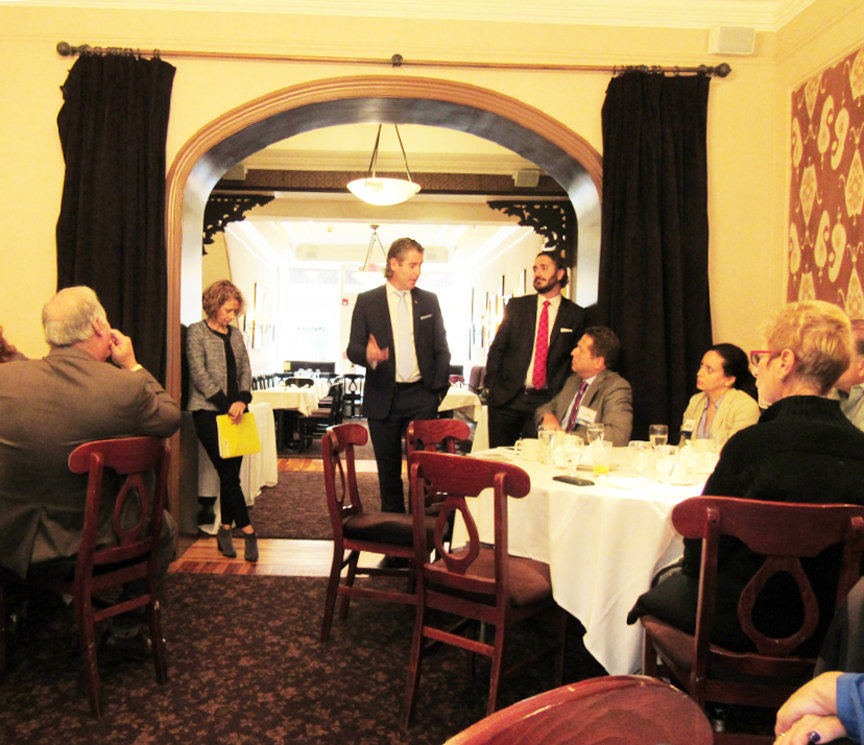It was fitting that a few minutes into the Hoboken Chamber of Commerce’s “Let’s Talk Parking” roundtable on Thursday, Oct. 1, nearly half the audience had to suddenly get up and move their cars to avoid tickets due to the street sweeper.
After the ironic turn of events, the president of the Hoboken Chamber of Commerce Richard Mackiewicz introduced the morning’s speakers for the event held at Amanda’s Restaurant: former chief of staff of the NYC Department of Transportation Margaret Newman, Sergio Fernández de Córdova of P3 consulting, and James F. Murphy from P3.
Three experts were on hand whose backgrounds range from urban design to infrastructure development to technology. The morning’s roundtable was focused on addressing how new technology, community input, and smart planning could help to solve one of Hoboken’s most persistent problems.
Some of the technological capabilities that were outlined include enabling driver to pay the meter on their smart phone and tapping an app to check for available spots at a municipal garage.
____________
Airing out the issue
About 30 people were in attendance including chamber members, Hudson County Freeholder Anthony Romano, and President of the Fund for a Better Waterfront James Vance.
“The takeaway from today was just to give folks an idea of what’s available to them,” said James Murphy of P3 Global Management, after the event. “Like how can they educate themselves and have resources to go to, such as architects, urban designers, and folks that are involved on a municipal level.”
Murphy, who has worked in innovative technologies since the 2001 and lives in Hoboken, noted during the talk that parking congestion has become a sort of “new norm” that shouldn’t be the case. He said festivals such as the recent Italian Festival and the Fall Arts and Music Festival should be easy to access for drivers instead of being a deterrent. For city events, visitors are often encouraged to use the various public modes of transportation here – ferries, light rail, and NJ Transit trains.
Despite first moving to Hoboken in 2007 (he left and returned in 2011), Murphy said his parents have only visited him on about four occasions due to the hassle of looking for a place to park.
The numbers
Although they didn’t get far into a discussion of local policy, there are changes coming to the way Hoboken deals with parking.
In 2013, the city hired Arup, a nationally-recognized planning firm with offices in New York City and Newark, to develop a set of proposals to address the city’s overwhelming demand for parking spots. The city intends to execute potential changes in the next five years that range from repainting curbs to building new garages.
Arup has already released a report looking at the reasons for the city’s parking problems. Many residents have cars but only use them occasionally. Additionally, there is enough free parking that residents don’t use the more expensive city garages. Arup also said the signage and policies are sometimes unclear, there aren’t enough loading zones or commercial guidelines, and the rules about driveways and curb cuts are inconsistent.
According to a study done by Arup, 60 percent of the Hoboken households that do have cars don’t use them to commute to work, creating a growing need for car storage during the weekday.
Of the 9,195 Hoboken residents who drive out of the city to work every day, 8,488 non-resident employees drive into the city, hence few spaces left for visitors.
At the roundtable, Vance mentioned that the city’s fee structure makes street parking more appealing than garages. An on-street permit is a mere $15 per year for residents, whereas residents can pay over $150 per month to park in city garages all day.
Visitors also often opt for a metered spot, which costs $2 per two hours rather than $10 for the same period in a municipal garage.
Working together
Some of the technological capabilities that were outlined include enabling drivers to pay the meter on their smart phone, and tapping an app to check for available spots at a municipal garage.
During the latter portion of the two-hour event, Romano voiced concerns about how the city’s on-street Zipcar and bike share programs could ultimately decrease the amount of available spots throughout the city. Zipcars take up more than 40 spots in town. However, they are meant to gradually decrease car ownership in town. In fact, since car sharing was implemented, requests for resident parking permits have dropped.
Newman, who has also been an architect in New York City for over fifteen years and currently runs her own company More Urban, said a partnership between residents and the city is crucial.
Steven Rodas can be reached at srodas@hudsonreporter.com.
